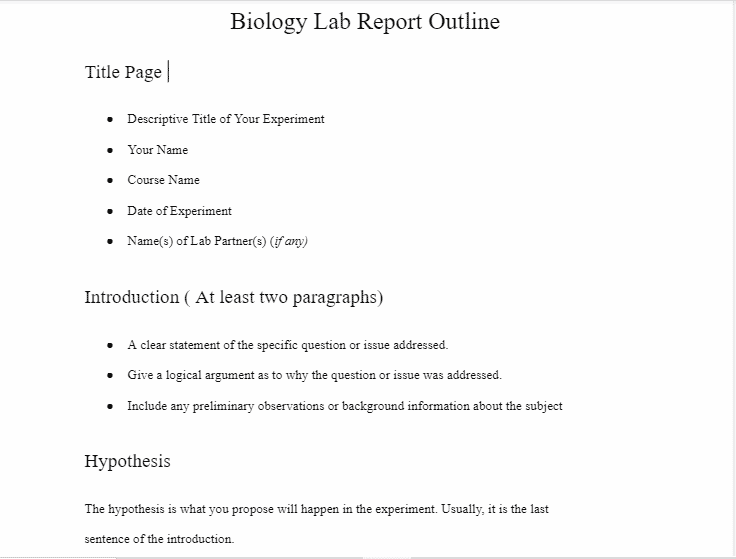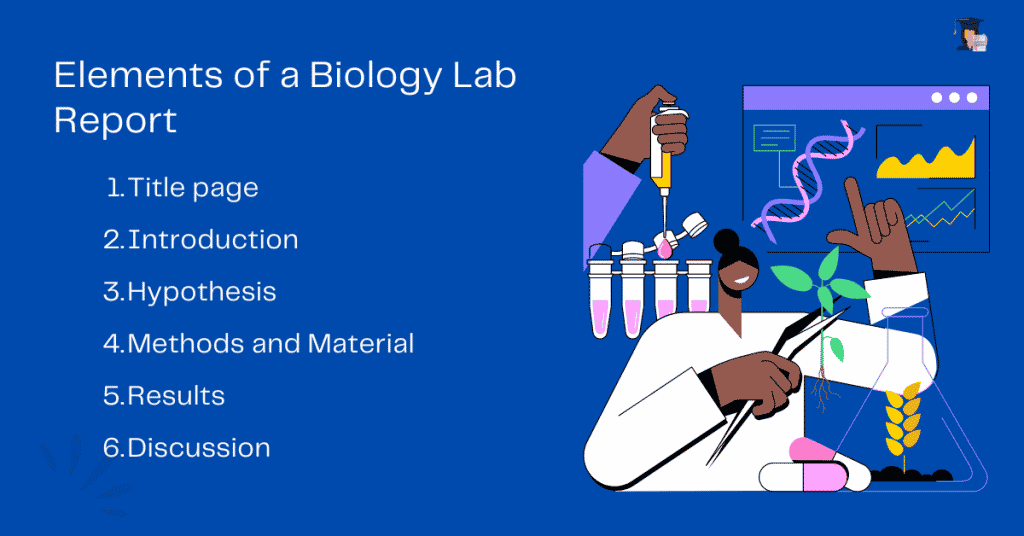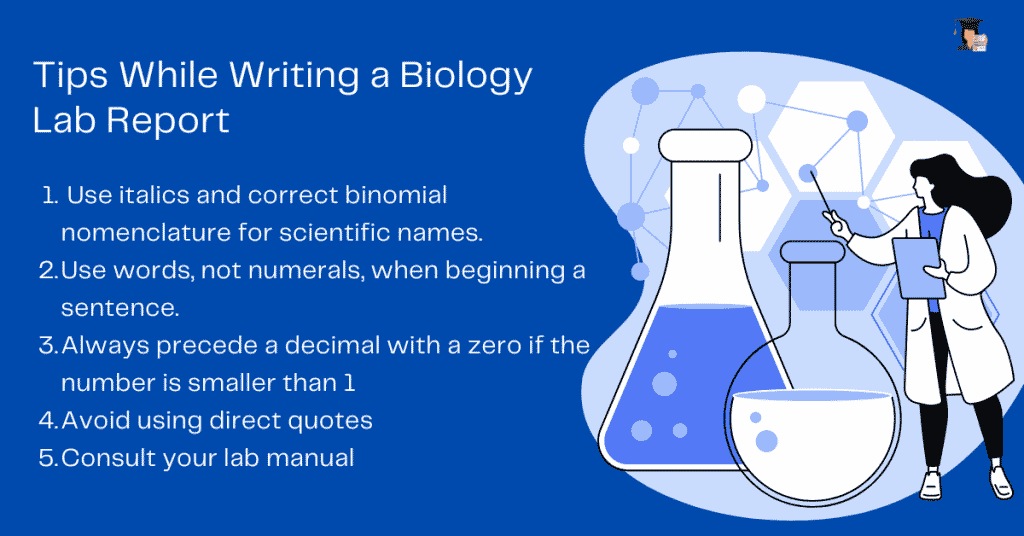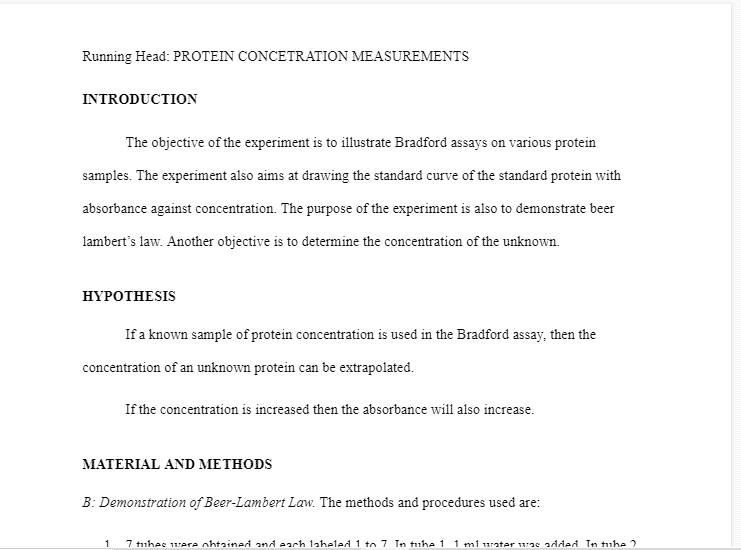Biology Lab Report Complete Writing Guide
Biology Lab Report Complete Writing Guide In college, lab reports are the most critical part of your day-to-day assignment, and it may sometimes seem like an overwhelming task. So not worry, this biology lab report writing guide will be helpful for every student who wants to learn how to write this type of lab report […]
To start, you canBiology Lab Report Complete Writing Guide
In college, lab reports are the most critical part of your day-to-day assignment, and it may sometimes seem like an overwhelming task. So not worry, this biology lab report writing guide will be helpful for every student who wants to learn how to write this type of lab report effectively. If after reading this article you still have difficulty writing your lab report our Biology academic writers are always ready to help. Let’s get started!
What is a Biology Lab Report?
This is a written document that describes the procedures and results of an experiment performed in a biology class. The lab report is integral to scientific biology communication and allows others to review your work and replicate your results.
Why is it important for students? The reports are essential for you because they help assess whether students understand the concepts covered in class. In addition, the lab reports provide valuable hands-on experience that can help students hone their laboratory skills. By reading and evaluating lab reports, instructors can better understand which students require additional guidance and which are on track.
So now that you know what a biology lab report is and its importance, we can begin to cover the sections typically included in this document and some tips for writing each section.
Structure of a Biology Lab Report
With the structure in mind, writing a successful this type of lab report will be easy to flow. Its important to understand the structure because a biology lab report has a different structure compared to a biology paper. Simply, take some time to plan out each section and understand the importance of each. Now, let’s take a closer look at compiling each part correctly to ensure that your lab report will be well-organized and informative.
Abstract
An abstract is a summary of a lab report. Its purpose is to introduce the reader to the experiment. The abstract should be one paragraph and should not exceed 250 words. It should begin with a statement of the problem or purpose of the investigation, followed by a description of the methods, results, and conclusions. The abstract should be clear and objective, and it should not include any interpretation of the data. Do not include your references in the abstract.
Introduction
The introduction serves several purposes. It should grab readers’ attention and make them want to read more. First, it introduces the report’s topic and provides background information about the experiment. Second, it states the hypothesis, or what the researcher predicts will happen during the experiment. Finally, it explains the rationale for the investigation or why the researcher believes the results will be meaningful. To write a successful introduction, you must state all of this information.
Materials and Methods
In the lab report, the materials and methods section is where you will describe the materials used in your experiment and the methods you used to collect your data. The area is crucial because it allows readers to understand how you obtained your results and whether or not they are reliable.
When writing the materials and methods section, it is vital to be clear and present factual information. Begin by describing the materials you used, including any instruments or chemicals. Then, define the steps you took to collect your data. Be sure to include enough detail so that readers can replicate your experiment if they wish.
Results
The results section of a lab report is where you present the data that you have collected during your experiment. The data can take many forms, including tables, graphs, charts, and illustrations. It is crucial to organize your results in a way that is clear and easy to understand.
Always start with a summary of your findings before moving on to more detailed information. When presenting numeric data, be sure to include units of measurement. Explain what these mean to your hypothesis if you discuss trends or patterns. The results section should provide a clear overview of your findings.
Discussions
When writing this type of lab report, the discussion section is where you explain the significance of your findings. It is where you will discuss what your results mean about your hypothesis. You will also need to discuss any limitations of your study and make suggestions for future research. To write a good discussion section, you need to understand your data and what it means clearly. You also need to be able to analyze your results and draw logical conclusions critically. With a bit of practice, you can write a discussion section that accurately reflects the significance of your findings.
Citation
The citations section of the lab report lists all the sources you used in your research. It includes books, articles, websites, and any other materials that you consulted in your work. For each source, you will need to have the author’s name, the work’s title, the date of publication, and the URL (if applicable). You should format all this information according to the style guide that your instructor has specified. In addition to listing your sources, you should briefly explain how you used each in your research. It will help show your instructor that you have read and understood the material you have cited.
Biology Lab Report Outline Template
Here is an outline that will help you get started with your lab report the right way.


How to Write a Biology Lab Report
The writing process of a lab report may seem daunting, and we know how crazy busy you already find yourself with your studies. But do not worry. We will ease your task and provide a clear overview of what is expected in every lab report section.
Write the Introduction and Hypothesis
When writing the introduction to a lab report is essential because it introduces the problem you will be investigating and your hypothesis. It also provides background information that will help the reader understand your experiment. Start by stating the issue you are studying. Then, present your theory.
Finally, give some background information about the biology concepts relevant to your experiment. It will help the reader understand your data and conclusions. Remember, the introduction aims to set up the investigation and provide all the necessary information for understanding the results. Therefore, ensure to include all essential elements and beware of repeating information from other report sections.
Example of a Biology Lab Report Introduction

Include Materials and Methods Used
The section should include a detailed description of the procedure and a list of all the materials used. It is also important to mention any safety precautions taken during the experiment. Checking the lab manual before starting the investigation is an excellent way to ensure all necessary materials are available. It is also helpful to understand the procedure clearly so it can you can carry it out safely and accurately. By taking these precautions, students can ensure that their lab reports are complete and accurate.
Example of a Biology Lab Report Material and Methods

Present the Lab Results
The results section of the lab report is where you will present the data that you have collected during your experiment. In other words, you will need to provide an interpretation of the results. The interpretation should be based on thorough data analysis and supported by evidence from the literature. It is also essential to discuss the results’ implications and put them into context.
For example, if the results were unexpected, why do you think that is? What does this mean for future research in this area? Explaining the results helps solidify your findings and helps to ensure that your reader understands what you have discovered. It will help your readers understand why the experiment produced those results and how they contribute to your understanding of the topic.
Example of a Biology Lab Report Results Section

Discussion
The conclusion section of the lab report is where you summarize your findings and present your conclusions. The area is where you answer the question, “What did you learn?” You should briefly restate the purpose of the experiment and describe the main findings.
Then, you will want to interpret these findings and discuss their meaning in terms of the hypothesis.
- Did the results support the hypothesis or not?
- What other factors could have influenced the results?
Finally, you will want to propose further research ideas that could help clarify the current experiment’s results. In short, the conclusion section is where you tie everything together and show what your investigation has contributed to our understanding of biology.
Example of Biology Lab Report Discussion

Citation
The lab report’s citation section is where you will be required to list all the sources you used in your experiment. There are two main styles for citing sources in the lab report:
- MLA style uses brief parenthetical citations in the text
- APA style uses a more complex system of in-text citations and reference lists.
Both types have their own rules and guidelines, so consult a style manual if you are unsure how to format your citations. In general, all lab reports should include a citation section so readers can easily find the sources you used in the experiment and also avoid being flagged for plagiarism.

Formatting Your Report
Font size & type– It is essential to use a font size and style that is easy to read. Readable font size and style can help ensure that your lab report is understandable and informative. Additionally, using a legible font will help make your lab report more visually appealing, making it more likely to be read and used by other scientists.
Page numbering– It may seem like a small detail, but it can make a big difference in the clarity and organization of your writing. By numbering your pages, you can quickly and easily reference specific sections of your report. It will be beneficial if you need to make changes or corrections later on. In addition, numbering your pages will help your reader follow your train of thought more easily.
Margins– Using margins is essential because lab reports are typically lengthy, and margins help create visual breaks that make the report easier to read. Margins also help to ensure that all of the information in the report is appropriately aligned. This is especially important when including tables and graphs, as they can be challenging to read if they are not correctly aligned.
Add headings for your sections– It is crucial to add headers to each section when writing your lab report. First, titles provide a clear structure for the message, making it easier to read and navigate. Second, headings help to highlight essential information and results, making them easier to find and understand. Finally, titles can help clarify the report’s purpose, ensuring readers know what they are supposed to be looking for.
Tips on How to Write the Best Biology Lab Report
With these tips, you’ll be well on your way to writing an excellent lab report that will impress your instructors.
Use italics and Correct Binomial Nomenclature for Scientific Names
A biology lab report is incomplete without using italics and correct binomial nomenclature for scientific names. Italics are used to emphasize words or phrases, which can be beneficial in a lab report to highlight the scientific names of organisms. Binomial nomenclature is the system of using two Latinized names to refer to a particular organism, and it is essential for correctly identifying organisms in a lab report. Using italics and correct binomial nomenclature, you can ensure that your lab report will be accurate and correctly formatted.
Use Correct Paragraph Structure
If you’re writing the lab report, one fantastic tip is to ensure each paragraph covers only one topic. It will help keep your writing clear and make it easier for your reader to follow. Generally, each section should contain a topic sentence, several supporting evidence, and a concluding sentence. Once you’ve got the hang of this basic structure, you’ll be well on writing an effective lab report!
Use Subheadings
Ensure you use subheadings, which will help you organize your thoughts and break down the report’s different sections. For instance, you might have an area on background information, followed by sections on materials and methods, results, and discussion. Subheadings make it easy for readers to find the information they are looking for and follow your train of thought. Additionally, it can help you stay focused as you write and ensure that all the critical points are covered.
Avoid using direct quotes.
Another practical writing tip for the lab reports is avoiding direct quotes. Direct quotes can be helpful in some cases, but generally, it is better to paraphrase what you have observed or what your sources have said. It will make your writing more concise and help show that you have understood the material. When paraphrasing, give credit to the head by providing a citation. If you use a direct quote, enclose it in quotation marks and provide an authority.
Avoid using contracted words.
For the lab report, you should avoid using contracted words. While contractions might be okay in casual writing, they can make your report sound unprofessional. Therefore, it’s best to avoid contractions and use total words instead. For instance, instead of “don’t,” write “do not.” It will make your report more accurate and readable. In addition, using total words instead of contractions can help ensure that your meaning is clear.
Consult your lab manual.
Examining your biology lab manual is a fantastic way to start writing your lab report. Your manual likely contains all the information you need to properly format and write your report, including any specific instructions from your professor. In addition, consulting your manual can help ensure that you include all the necessary sections in your report. For example, most lab reports must consist of an introduction, methods section, results section, and discussion. By consulting your manual, you can ensure that you have all the critical areas in your report.
Use words, not numerals, when beginning a sentence.
Starting a sentence with a number can confuse your reader, so it is generally advisable to avoid this construction. For example, you will want to communicate your findings when writing a lab report. To do this effectively, use descriptive phrases instead of numerical values. For instance, instead of writing ” there are 50 cells in the sample,” try ” the sample contains a moderate number of cells.” It will help to ensure that your reader understands your data correctly. In addition, using words instead of numbers will make your writing more aesthetically pleasing and engaging.
Always precede a decimal with a zero if the number is smaller than 1
A common mistake is forgetting to include a leading zero before a decimal point when the number is less than one. For example, the correct way to write 0.5 is with a zero in front of the decimal, while the incorrect way would be to write .5 without the leading zero. This small detail may seem inconsequential, but omitting the zero can change the meaning of the number. For example, 0.5 could represent half of a percent, while .5 could represent 50%. So, if you want to ensure your lab report is error-free, always include a leading zero before decimal points when necessary.
Proofread your report
Proofreading your lab report is a great writing tip that can help you improve the quality of your work. Reviewing your information for errors can ensure that your work is accurate and free of mistakes. Additionally, proofreading can also help you to identify any areas where you may need to provide additional information or clarification.

In Conclusion
With the clear guide we have shared on how to structure and excellently write a tip-top biology lab report, you are well on your way to impressing your instructors with an intelligent lab report. What are you waiting for! Get on with your lab report assignment now!
We hope this article was helpful. Leave a comment below, and remember, if you get stuck or need help along the way, don’t hesitate to contact Peak Essays. We would be happy to assist you in any way possible. Good luck with your lab report.
Example of Biology Lab Report

Calculate the price of your order
Select your paper details and see how much our professional writing services will cost.
- Freebies
- Format
- Formatting (MLA, APA, Chicago, custom, etc.)
- Title page & bibliography
- 24/7 customer support
- Amendments to your paper when they are needed
- Chat with your writer
- 275 word/double-spaced page
- 12 point Arial/Times New Roman
- Double, single, and custom spacing
-
We care about originality
Our custom human-written papers from top essay writers are always free from plagiarism.
-
We protect your privacy
Your data and payment info stay secured every time you get our help from an essay writer.
-
You control your money
Your money is safe with us. If your plans change, you can get it sent back to your card.
How it works
-
1
You give us the detailsComplete a brief order form to tell us what kind of paper you need.
-
2
We find you a top writerOne of the best experts in your discipline starts working on your essay.
-
3
You get the paper doneEnjoy writing that meets your demands and high academic standards!
Get your own paper from top experts
Order nowPerks of our essay writing service
We offer more than just hand-crafted papers customized for you. Here are more of our greatest perks.

